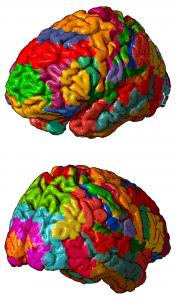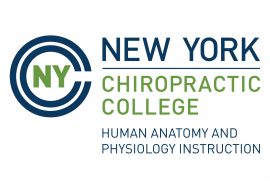Host Kevin Patton discusses the many ways case studies can be used in teaching, why they enhance learning, and where to find them. Also, updates in factors underlying left-handedness, functional maps of the brain, and reversing biological age, plus some tips on responding to student questions.
00:44 | Left-handedness
02:54 | Responding to Students
22:30 | Sponsored by HAPS
22:59 | Mapping Brain Functions
26:55 | Sponsored by AAA
27:14 | Reversing Age
30:32 | Sponsored by HAPI Online Graduate Program
31:18 | Case Studies in Teaching A&P
47:59 | Staying Connected
If you cannot see or activate the audio player click here.
Questions & Feedback: 1-833-LION-DEN (1-833-546-6336)
Follow The A&P Professor on Twitter, Facebook, Blogger, Nuzzel, Tumblr, or Instagram!
If the left half of the brain controls the right half of the body then only left handed people are in their right mind. (W.C. Fields)
1 | Left-Handedness
2 minutesA new report suggests that left-handedness, which one in ten of us exhibit, is partially influenced by genes. One effect of these genes is to change the structure of our body cells' cytoskeleton. Of course, a lot more work has to be done. By left-handers and right-handers alike.
- Left-handed DNA found - and it changes brain structure (brief summary article) my-ap.us/2AfTLAQ
- Handedness, language areas and neuropsychiatric diseases: insights from brain imaging and genetics (research article) my-ap.us/2AbWACQ

2 | Responding to Students
19.5 minutesHalf of students don't read the syllabus, don't read directions, don't listen to us—which can produce some frustrations when they reach out to us with questions that they already have the answer for. Somewhere nearby them. Kevin gives some tips on how to to handle these with grace and ease (taking barely any time or effort), as well as advice on heading them off before they are asked.
- The Syllabus Episode | Bonus | Episode 24
- Connecting in The Distance Course Special | Episode 50
- TextExpander (software to cut and paste automatically) theapprofessor.org/textexpander
- Google forms (software to make inquiry forms for students that require them to give specifics about their question) my-ap.us/2AfzbQU

3 | Sponsored by HAPS
0.5 minutesThe Human Anatomy & Physiology Society (HAPS) is a sponsor of this podcast. You can help appreciate their support by clicking the link below and checking out the many resources and benefits found there. There are a bunch of 1-day regional workshops scattered all over the continent. There's probably one near you coming up this year (or next)!
Anatomy & Physiology Society
theAPprofessor.org/haps

4 | Mapping Brain Functions
4 minutesWe've all see various functional maps of the human brain. But once you get down to the smaller regions, or parcels, it gets weird. Beyond a certain resolution, things are very flexible. Because functions of tiny parcels vary with the state of that region of the brain in any given moment, we will probably not be able to produce a high-resolution functional map of the brain—even for any one individual.
- There is no single functional atlas even for a single individual: Parcellation of the human brain is state dependent (research article) my-ap.us/2Aighc0
- Brodmann areas (maps and explanation) my-ap.us/2Qc2COA

5 | Sponsored by AAA
0.5 minutes- A searchable transcript for this episode, as well as the captioned audiogram of this episode, are sponsored by the American Association for Anatomy (AAA) at anatomy.org.

6 | Reversing Age
3.5 minutesCan biological age be reversed? Some research in a small group of older men suggest it may be possible. Using a cocktail of common drugs, their epigenomes showed a younger biological age. Hmm.
- First hint that body’s ‘biological age’ can be reversed (brief summary from Nature) my-ap.us/2Ad78BR
- Reversal of epigenetic aging and immunosenescent trends in humans (research article from Aging Cell) my-ap.us/2AfUmCA
7 | Sponsored by HAPI Online Graduate Program
1 minuteThe Master of Science in Human Anatomy & Physiology Instruction—the MS-HAPI—is a graduate program for A&P teachers. A combination of science courses (enough to qualify you to teach at the college level) and courses in contemporary instructional practice, this program helps you power up your teaching. Kevin Patton is a faculty member in this program. Check it out!
nycc.edu/hapi

8 | Case Studies in Teaching Anatomy & Physiology
16.5 minutesIn this discussion, Kevin defines what a case study is, described some different sorts of case studies, explains why case studies are such a powerful learning experience, and give sources for peer-reviewed, classroom-tested case studies for A&P. And a few odd and creative ideas, one from listener Christy Pitts, thrown in as a bonus! We're all about bonuses here.
- Bloom's taxonomy my-ap.us/2ZWfLjt
- Fink's taxonomy of significant learning my-ap.us/2Q4IQEN
- National Center for Case Study Teaching in Science my-ap.us/ScienceCases
- Grumpy Old Man: Hypercalcemia and the Parathyroid Gland (this case study & others by Sheri L. Boyce) my-ap.us/2ZUWAq3
- Life Science Teaching Resource Community my-ap.us/LifeSciTRC

If the hyperlinks here are not active, go to TAPPradio.org to find the episode page.
- More details at the episode page.
- Transcript available at the script page.
- Listen to any episode on your Alexa device.
- Need help accessing resources locked behind a paywall? Check out this advice from Episode 32 to get what you need! https://youtu.be/JU_l76JGwVw?t=440
Sponsors
Transcript and captions for this episode
are supported by the
also provides marketing support for this podcast.
Distribution of this episode is supported by
NYCC's online graduate program in
Clicking on sponsor links
helps let them know you appreciate
their support of this podcast!
Referrals also help defray podcasting expenses.
The A&P Professor® and Lion Den® are registered trademarks of Lion Den Inc. (Kevin Patton)
Click here to listen to this episode—or access the detailed notes and transcript.

1 comment:
Reversing age study: besides being small and preliminary they only studied men.
Post a Comment